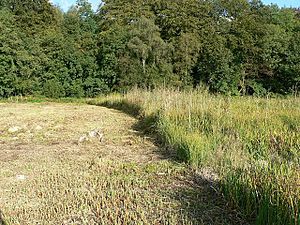Loynton Moss facts for kids
Quick facts for kids Loynton Moss |
|
|---|---|

Reed bed (formerly Blakemerly Pool) in Loynton Moss
|
|
| Lua error in Module:Location_map at line 420: attempt to index field 'wikibase' (a nil value). | |
| Location | near Woodseaves, Staffordshire |
| Area | 13 hectares (32 acres) |
| Operated by | Staffordshire Wildlife Trust |
| Designation | Site of Special Scientific Interest |
Loynton Moss is a special nature reserve in Staffordshire, England. It's managed by the Staffordshire Wildlife Trust. This amazing place is close to the village of Woodseaves. You can find it right next to the Shropshire Union Canal, which flows between Norbury and High Offley.
Contents
Exploring Loynton Moss
Loynton Moss covers about 13 hectares (32 acres), which is like 26 football fields! It's so important that it's called a Site of Special Scientific Interest. This means it has rare plants, animals, or geology.
You can explore parts of the reserve on walking trails. However, some areas are hard to reach. These include thick reedbeds and wet woodland. During summer, you might find mosquitoes in the wetter spots.
How Loynton Moss Was Formed
The unique landscape of Loynton Moss was created after the last ice age. Imagine huge glaciers covering the land. As they melted, chunks of ice were left behind. These chunks were called "dead ice."
When this dead ice finally melted, it left a big hole in the ground. This hole is known as a kettle hole. Water filled the hole, forming a lake. Over time, the lake slowly filled with peat, turning into the boggy land we see today. This type of peaty, boggy area is called a Moss.
Different Habitats at Loynton Moss
Loynton Moss has several different types of environments. Each one is home to unique plants and animals.
Woodlands and Grasslands
There are dry wooded areas where you can see beautiful bluebells in the spring. These flowers create a stunning carpet of blue.
A big part of the reserve is grassland. The Staffordshire Wildlife Trust acquired this land in 2000. Before that, it was a wetland that farmers drained in 1970 to grow crops.
Wetlands and Rare Species
Loynton Moss also has areas of reed bed and wet woodland. One special type of wet woodland here is an alder carr. This means it's a swampy forest where alder trees grow.
You can find some uncommon plants in these wet areas. These include the marsh cinquefoil and cowbane. The wetlands are also a haven for insects. Many species of rare moths, butterflies, and other insects live here.
These insects attract many birds to the reserve. Birds like the willow warbler and reed bunting love to feed on the insects found in this special habitat.
Managing the Water Levels
Some birch trees at Loynton Moss drink a lot of water. This can lower the water levels in the wetland during summer. To help keep the wetland healthy, some birch trees have been cut down. The reserve also carefully watches its ditches and land drains to manage water flow.


